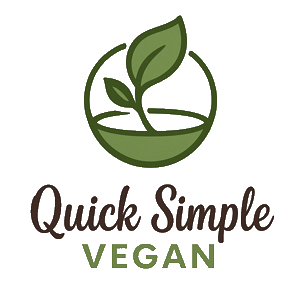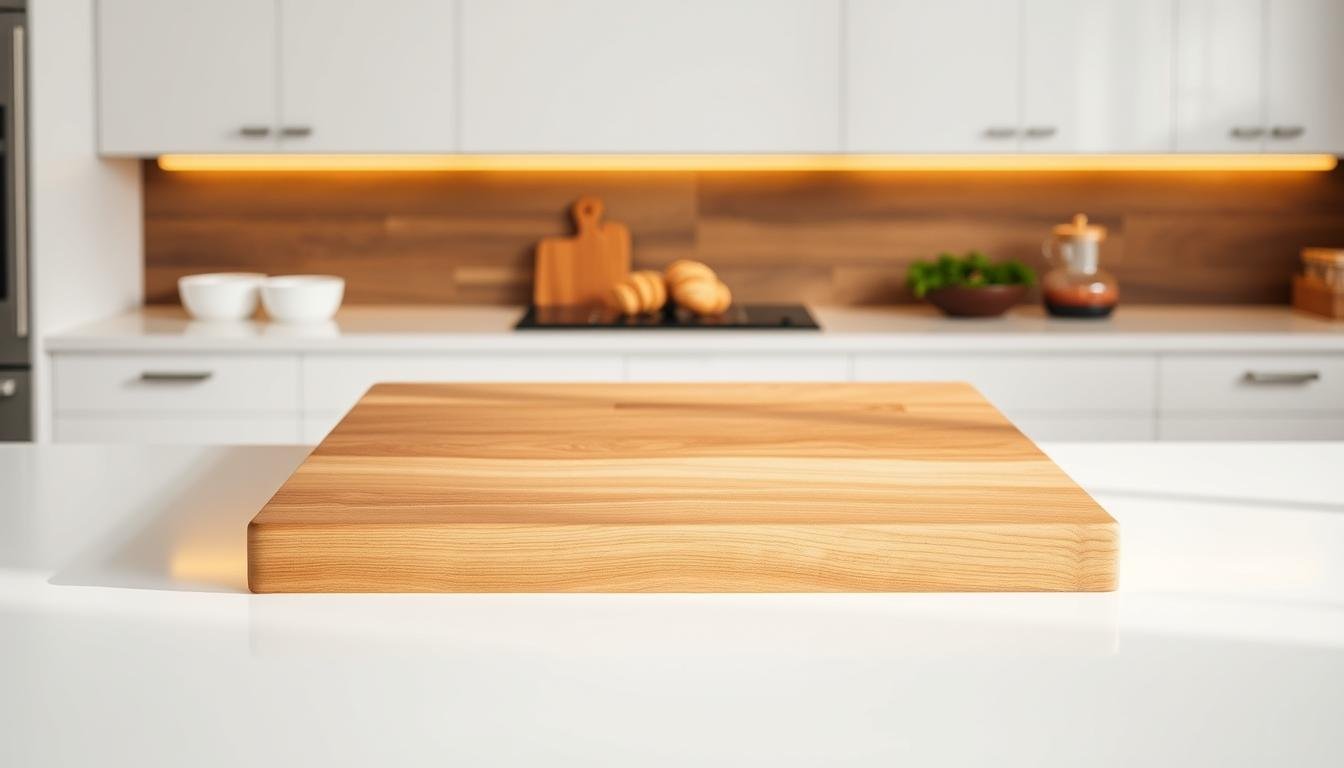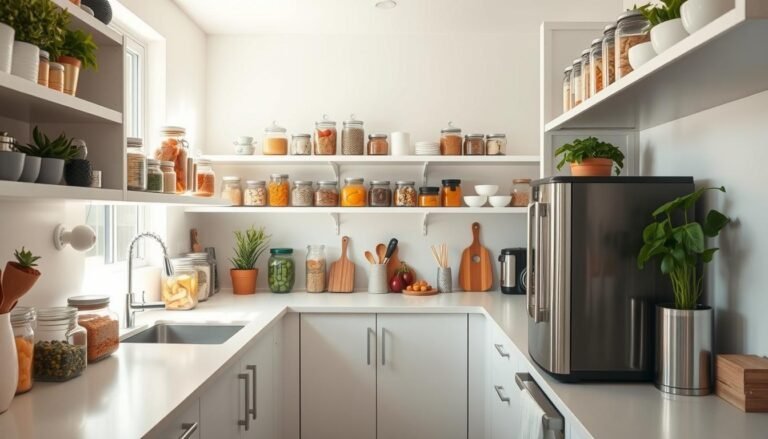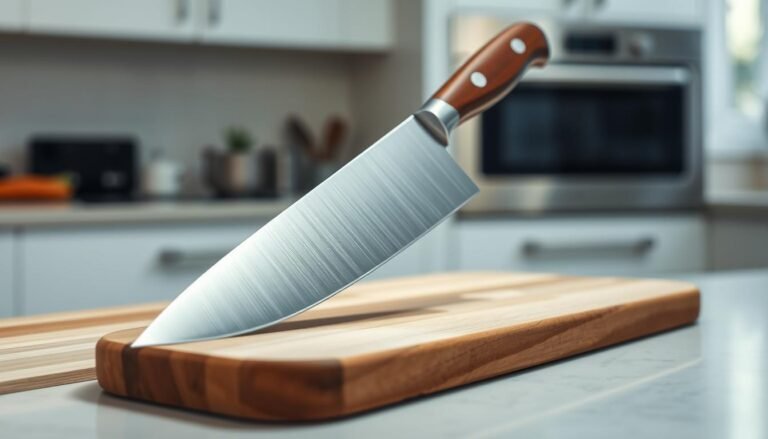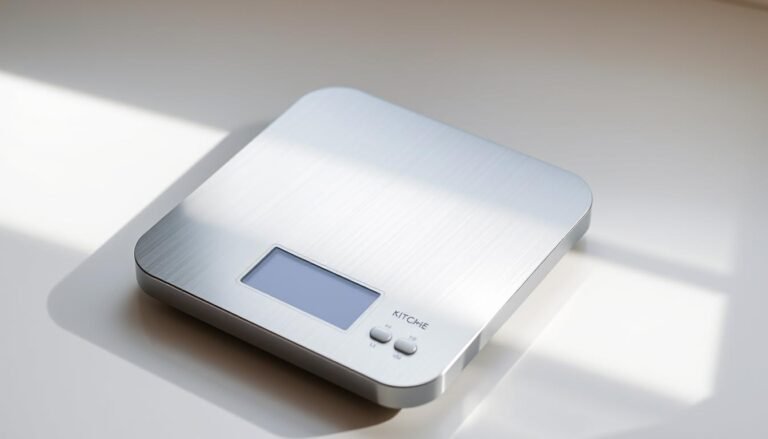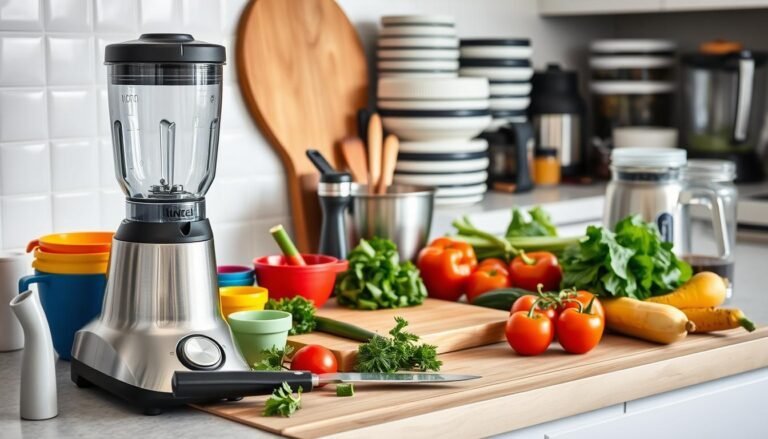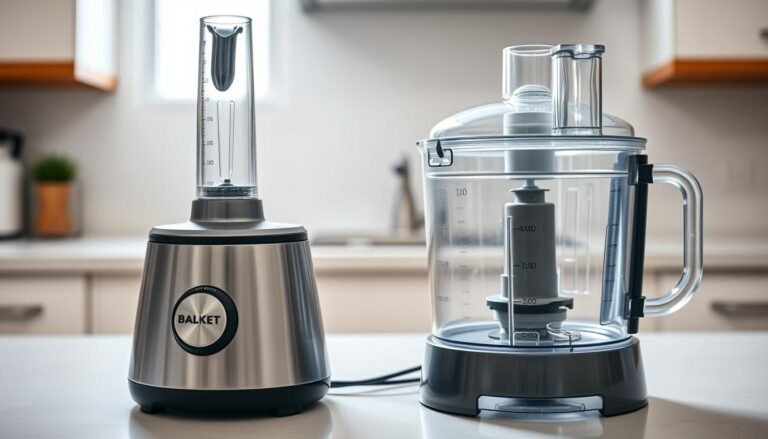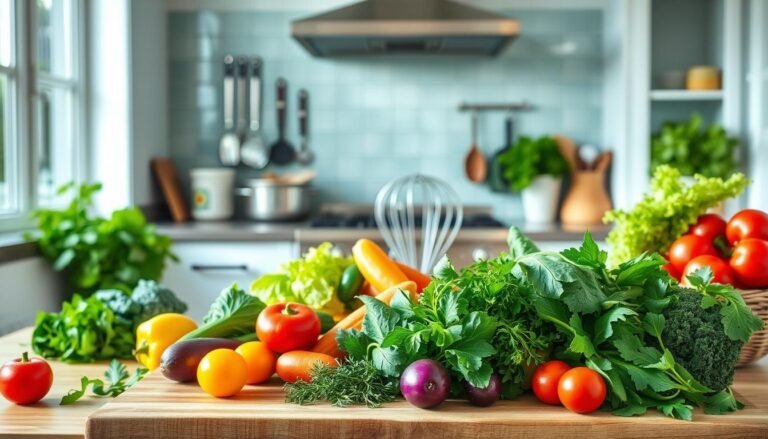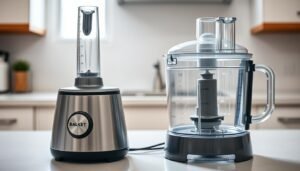Disclosure: This Post Contains Affiliate Links; We earn a commission on purchases.
A good kitchen cutting board is key for daily cooking. It gives you a big space to work and keeps your knives safe. It’s a simple but important tool that can make your cooking better.
The right cutting board changes your cooking for the better. It gives you a clean, stable place to prepare food. It also keeps your knives sharp.
Key Takeaways
- A good cutting board is key for daily cooking.
- The right cutting board gives you lots of space.
- It keeps your knives safe while you cook.
- It makes your cooking at home better.
- It helps keep your knives sharp.
Why the Right Cutting Board Matters
The right cutting board makes cooking better. It gives you a strong, safe, and efficient place to prepare food. A good cutting board helps your knives last longer, keeps your food safe, and makes your kitchen work better.
Impact on Knife Longevity
A soft cutting board is kind to your knives. Wood is a good choice because it’s gentle. The wrong board can dull knives fast, making cooking harder and risky.
Food Safety Considerations
Food safety is key, and the right cutting board helps. Boards that resist knife marks and are easy to clean, like some plastics or hardwoods, are safer. Cleaning them well is also important.
Workflow Efficiency in the Kitchen
Your kitchen’s flow improves with the right cutting board. A stable board with juice grooves helps you work faster. Having different boards for each food type stops contamination and makes cooking smoother.
In short, the right cutting board is vital. It keeps knives sharp, ensures food safety, and boosts kitchen efficiency. Picking the right one can greatly improve your cooking experience.
Types of Cutting Boards You Should Know
Choosing the right cutting board is key for cooks. The material and how it’s made affect its durability and upkeep. This is important for a good kitchen experience.
Wooden Cutting Boards: Classic and Durable
Wooden cutting boards are a classic choice. They look warm and natural, which many cooks like. They’re made from hardwoods like maple, walnut, or cherry.
These woods are dense and less likely to get scratched. A wooden cutting board lasts long if you oil it regularly. This keeps it from cracking.
Plastic Cutting Boards: Affordable and Dishwasher-Safe
Plastic cutting boards are popular for being cheap and easy to clean. They’re dishwasher-safe, which makes cleaning simple. But, they can get scratched and might have bacteria if not cleaned well.
Bamboo Cutting Boards: Eco-Friendly Option
Bamboo cutting boards are eco-friendly. Bamboo is a sustainable resource that grows fast. These boards are light, strong, and don’t hold bacteria well.
Specialty Materials: Glass, Composite, and Rubber
There are cutting boards made from glass, composite, and rubber too. Glass boards are easy to clean but can hurt knives. Composite boards are tough and don’t scratch easily. Rubber boards are great for meat because they don’t slip.
Knowing about each type helps cooks choose the best one for them. It’s all about what you need and like.
What Makes a Great Cutting Board for Daily Use
A good cutting board for daily use needs to balance a few key things. It should make cooking better. A top-notch cutting board can really help your kitchen run smoothly.
Durability and Longevity Factors
A durable cutting board is key for daily use. Choose boards made from quality materials that last. Hardwoods like maple and walnut are great because they’re tough and don’t scratch easily.
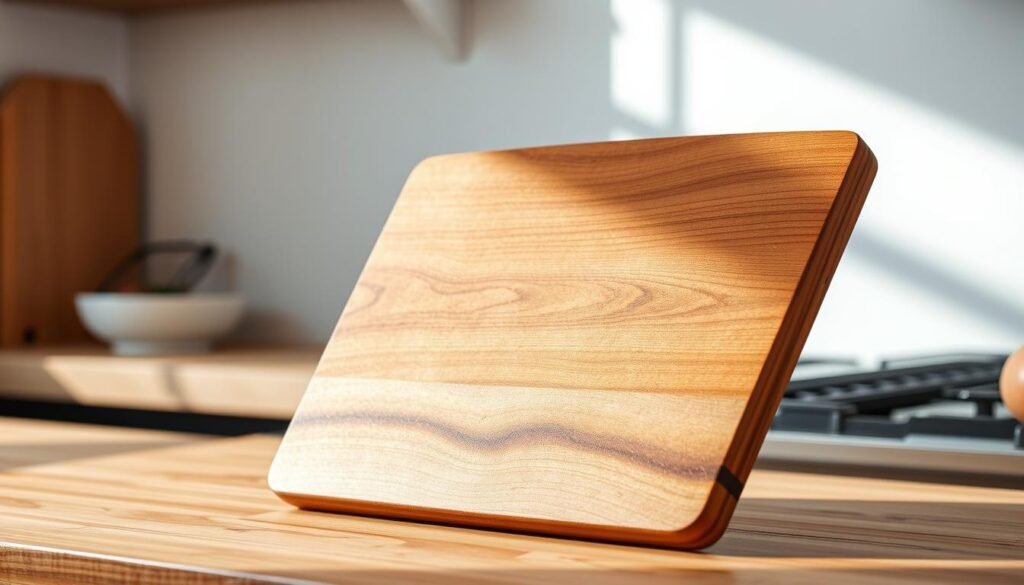
Easy Maintenance Requirements
It’s important for a daily cutting board to be easy to clean. Look for boards that are simple to care for. Many modern boards are dishwasher-safe, making cleaning easy.
Knife-Friendly Surface Characteristics
A surface that’s good for knives is essential. You want a board that won’t dull your knives. Bamboo and certain plastic boards are great for this.
Stability and Non-Slip Features
A stable, non-slip cutting board is safe and efficient. Look for boards with non-slip feet or silicone grips. These keep the board steady while you chop.
By focusing on these points, you can find a cutting board that fits your daily cooking needs. It will make cooking more fun and efficient.
Best Wooden Cutting Boards for Home Cooks
The best wooden cutting boards are both useful and beautiful. They are more than tools; they are kitchen friends. They can handle daily kitchen tasks well.
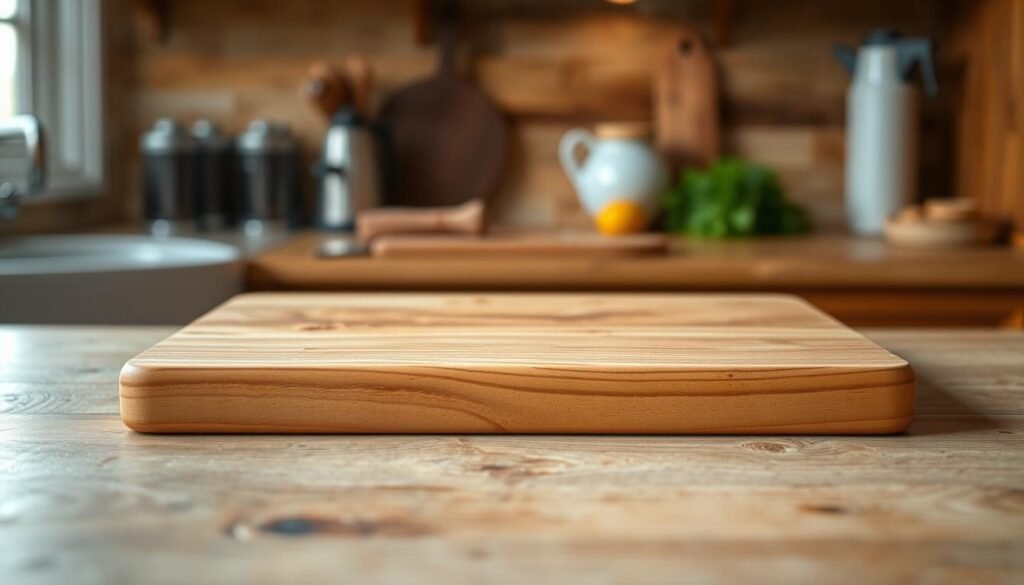
End-Grain vs. Edge-Grain Construction
Choosing the right wooden cutting board is key. End-grain cutting boards are made with wood ends up. This is gentle on knives and lasts longer. Edge-grain cutting boards have wood grain parallel to the surface. They give a smoother cut.
Top Hardwood Options
The hardwood used affects a cutting board’s strength and how well it works. Maple is light and resists stains well. Walnut is dark and very durable. Cherry is warm and has a fine grain.
Premium and Budget-Friendly Recommendations
There are many wooden cutting boards for different budgets. For a full review, check out Serious Eats.
High-End Investment Pieces
High-end wooden cutting boards use top materials and care. They last long and work great. They’re perfect for serious cooks who want the best.
Affordable Quality Options
Even on a tight budget, you can find good wooden cutting boards. They might not have all the fancy features. But they’re great for everyday use.
Best Plastic and Synthetic Cutting Boards
Plastic and synthetic cutting boards are great for home cooks. They are easy to clean and last a long time. This makes them a favorite in many kitchens.
Dishwasher-Safe Options for Easy Cleanup
Plastic cutting boards can handle hot water, making them dishwasher-safe. This makes cleaning them a breeze. For example, Roechling offers cutting boards that are easy to keep clean.
Color-Coding Systems for Food Safety
Plastic cutting boards often have color-coding systems. These systems help keep food safe by separating different types. This is key in stopping the spread of germs between foods.
Most Durable Plastic Board Materials
The strength of a plastic cutting board depends on its material. Polyethylene and polypropylene are top choices for their toughness.
Polyethylene Boards
Polyethylene boards are flexible and can handle scratches well. They’re perfect for those who need a board that’s both strong and flexible.
Polypropylene Alternatives
Polypropylene boards are stiff and can take a lot of use. They’re great for heavy tasks.
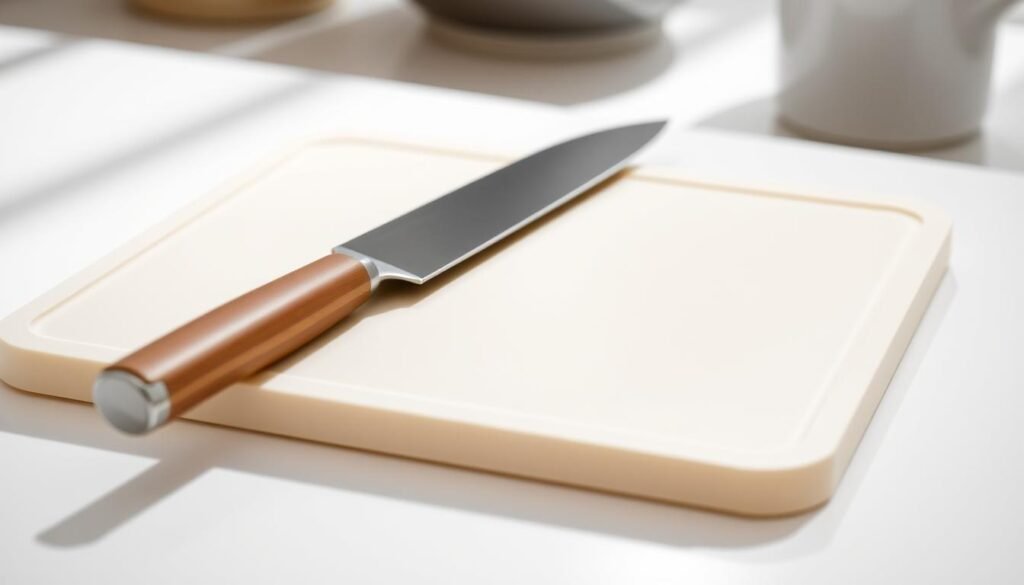
Specialized Cutting Board Options
For cooks who demand more, specialized cutting boards are available. They are made for specific tasks. These boards make kitchen tasks easier and more efficient.
Cutting Boards for Meat Preparation
Cutting boards for meat are essential for home cooks and chefs. They have juice grooves to catch meat juices. This keeps the kitchen clean and prevents cross-contamination.
Boards with Juice Grooves and Compartments
Some cutting boards have extra features like compartments. These specialty boards are great for carving meat or chopping veggies. The compartments help organize ingredients, streamlining cooking.
When looking for specialized cutting boards, consider these features:
- Durable construction for heavy use
- Easy-to-clean surfaces
- Juice grooves or compartments for messes
- Non-slip surfaces to prevent movement
Choosing the right cutting board for meat or other tasks improves kitchen workflow. It makes meal prep more fun.
Choosing the Right Size Cutting Board
Choosing the right cutting board size is key for efficient meal prep and kitchen organization. The size of your cutting board greatly affects your cooking experience. It matters from meal prep to cleanup.
Large Cutting Boards for Serious Meal Prep
Large cutting boards are great for serious meal prep. They offer lots of space for chopping ingredients. They’re perfect for cooking enthusiasts who often make complex meals.
A large cutting board lets you handle many ingredients at once. This makes meal prep more efficient.
Small Cutting Boards for Quick Kitchen Tasks
Small cutting boards are good for quick tasks like slicing fruits or cheeses. They’re ideal for small kitchens or when you need an extra cutting surface. Small cutting boards also work well for serving or as a secondary cutting area.
Space-Saving Storage Solutions
Think about storage options for your cutting board, no matter the size. Some cutting boards have built-in handles or can be hung on walls. This makes storage easier. Look for space-saving storage solutions like foldable cutting boards or those that can be stored vertically.
When picking a cutting board, think about your kitchen space and cooking habits. Here are important things to consider:
- Available kitchen counter space
- Type of cooking you do most often
- Storage options in your kitchen
Conclusion: Finding Your Ideal Cutting Board
Choosing the best cutting board is a personal choice. It depends on your cooking habits, kitchen space, and what you like. The perfect cutting board should be durable, easy to care for, and work well.
A good cutting board helps you cook better and safely. Think about the material, size, and special features like juice grooves or non-slip surfaces. This way, you can pick a cutting board that suits you.
The best cutting board matches your cooking style and makes your kitchen better. You might like a wooden, plastic, or bamboo cutting board. The most important thing is that it’s tough, easy to clean, and kind to your knives.
With the right cutting board, cooking becomes easier and more fun. A high-quality cutting board can make cooking a pleasure. It helps you do better in the kitchen and enjoy making meals.
FAQ
What is the best material for a cutting board?
Are wooden cutting boards better than plastic ones?
What is the difference between end-grain and edge-grain cutting boards?
Can I put my plastic cutting board in the dishwasher?
How do I maintain my wooden cutting board?
What size cutting board is ideal for everyday cooking?
Are bamboo cutting boards eco-friendly?
Can I use a cutting board for meat preparation?
How do I store my cutting board to save space?

Focused on simplicity and flavor, Ryan helps readers create quick vegan meals and snacks without the overwhelm. Whether you’re new to vegan cooking or just want to keep it simple, Ryan’s tips, guides, and no-fuss approach make plant-based eating accessible and enjoyable for everyone.
Subscribe to Our Newsletter
